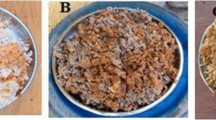Summary
Solid state fermentation (SSF) of canola meal has been carried out to reduce its phytic acid content using Aspergillus ficuum NRRL 3135. In certain batches, a complete reduction of phytic acid content in canola meal was achieved in 48 h. A larger amount of biomass in the inoculum and older inoculum increased the rate of phytic acid hydrolysis. The optimum moisture content of the medium was found to be 67% for phytic acid hydrolysis in an SSF process. The substitution of water in the semi-solid medium with acetate buffer resulted in faster reduction of the phytic acid content. A 15% increase in the amount of protein after 120 h of incubation was observed in the treated meal. The crude phytase preparation extracted from the canola meal after it was treated in an SSF process was also used for reduction of the phytic acid content in new batches of canola meal both in semi-solid medium and in liquid medium. In the semi-solid medium, 58% of the phytic acid was hydrolysed at 45°C in 20 h, while 100% hydrolysis was recorded at 50°C in 12 h in the liquid medium. The SSF process seems to be beneficial for the upgrading of canola meal by reducing both its phytic acid content and increasing the amount of protein.
Similar content being viewed by others
References
Alli I, Houde R (1987) Characterization of phytate in canola meal, 8th Progress Report. Canola Council of Canada, Winnipeg, Manitoba, pp 159–165
AOAC (1975) Official methods of analysis, 12th edn. Association of Official Analytical Chemists, Washington, D. C.
Blair R, Misir R, Bell JM, Clandinin DR (1987) The chemical composition and nutritional value of meal for chickens from triazine-tolerant canola, 8th Progress Report. Canola Council of Canada, Winnipeg, Manitoba, pp 51–57
Clandinin DR (1986) Canola meal for livestock and poultry. Canola Council of Canada, Winnipeg, Manitoba
Erdman JW Jr (1979) Oil seed phytates: nutritional implications. J Am Oil Chem Soc 56:736–741
Fardiaz D, Markakis P (1981) Degradation of phytic acid in oncom. J Food Sci 46:523–525
Gillberg L, Tornell B (1976) Preparation of rapeseed protein isolates. J Food Sci 41:1063–1069
Graf E (1986) Phytic acid — chemistry and applications. Pillsbury Co., Pilatus Press, Minneapolis
Harland BF, Harland J (1980) Fermentative reduction of phytate in rye, white and whole wheat breads. Cereal Chem 57:226–229
Harris D (1988) Canola digest. Canola Council of Canada, Winnipeg, Manitoba, 22:1–12
Haug W, Lantzsch HJ (1983) Sensitive method for the rapid determination of phytate in cereals. J Sci Food Agric 34:1423–1426
Irving GCJ, Cosgrove DJ (1972) Inositol phosphate phosphatases of microbiological origin: the inositol pentaphosphate products of Aspergillus ficuum phytases. J Bacteriol 112:434–438
Irving GCJ, Cosgrove DJ (1974) Inositol phosphate phosphatases of microbiological origin: some properties of partially purified phosphatases of A. ficuum NRRL 3135. Aust J Biol Sci 27:361–368
Lolas M, Markakis P (1977) Phytase of navy beans, J Food Sci 42:1094–1097
Lowry OH, Rosebrough NJ, Farr AL, Randall RJ (1951) Protein measurement with Folin phenol reagent. J Biol Chem 193:265–275
Maga JA (1982), Phytate: its chemistry, occurrence, food interactions, nutritional significance and methods of analysis, J Agric Food Chem 30:1–9
Raimbault M, Alazard D (1980) Culture methods to study fungal growth in solid state fermentation. Eur J Appl Microbiol Biotechnol 9:199–209
Sharma CB, Goel M, Irshad M (1978) Myoinositol hexaphosphate as a potential inhibitor of α-amylases of different origins. Phytochemistry 17:201–204
Shieh TR, Ware JH (1968) Survey of microorganisms for the production of extracellular phytase. Appl Microbiol 16:1348–1351
Shieh TR, Wodzinski RJ, Ware JH (1969) Regulation of the formation of acid phosphatases by inorganic phosphate in A. ficuum. J Bacteriol 100:1161–1165
Stone FE, Hardy RW, Spinelli J (1984) Autolysis of phytic acid and protein in canola meal, wheat bran and fish silage blends. J Sci Food Agric 35:513–519
Author information
Authors and Affiliations
Additional information
Offprint requests to: Z. Duvnjak
Rights and permissions
About this article
Cite this article
Nair, V.C., Duvnjak, Z. Reduction of phytic acid content in canola meal by Aspergillus ficuum in solid state fermentation process. Appl Microbiol Biotechnol 34, 183–188 (1990). https://doi.org/10.1007/BF00166777
Received:
Accepted:
Issue Date:
DOI: https://doi.org/10.1007/BF00166777




